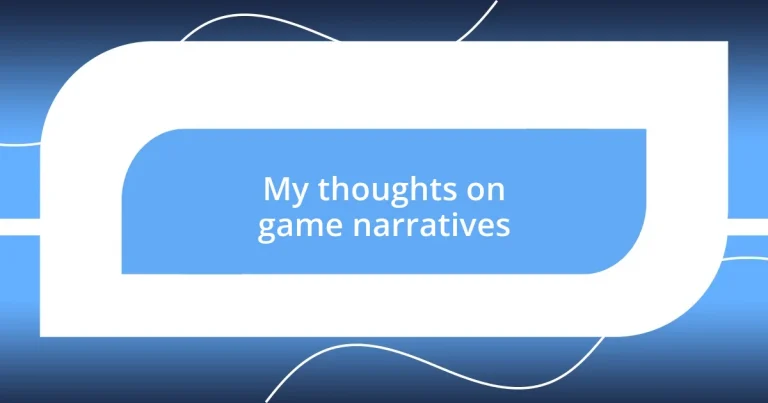Key takeaways:
- Game narratives significantly enhance emotional engagement and reflection, allowing players to connect deeply with characters and their journeys, as seen in titles like “The Last of Us” and “Red Dead Redemption 2.”
- Key elements of effective narratives include character development, central conflicts, world-building, and meaningful choices, all of which contribute to a lasting emotional impact on players.
- Future trends in game storytelling will likely involve immersive technologies and socially impactful themes, aiming to create deeper connections between players and the narratives they experience.
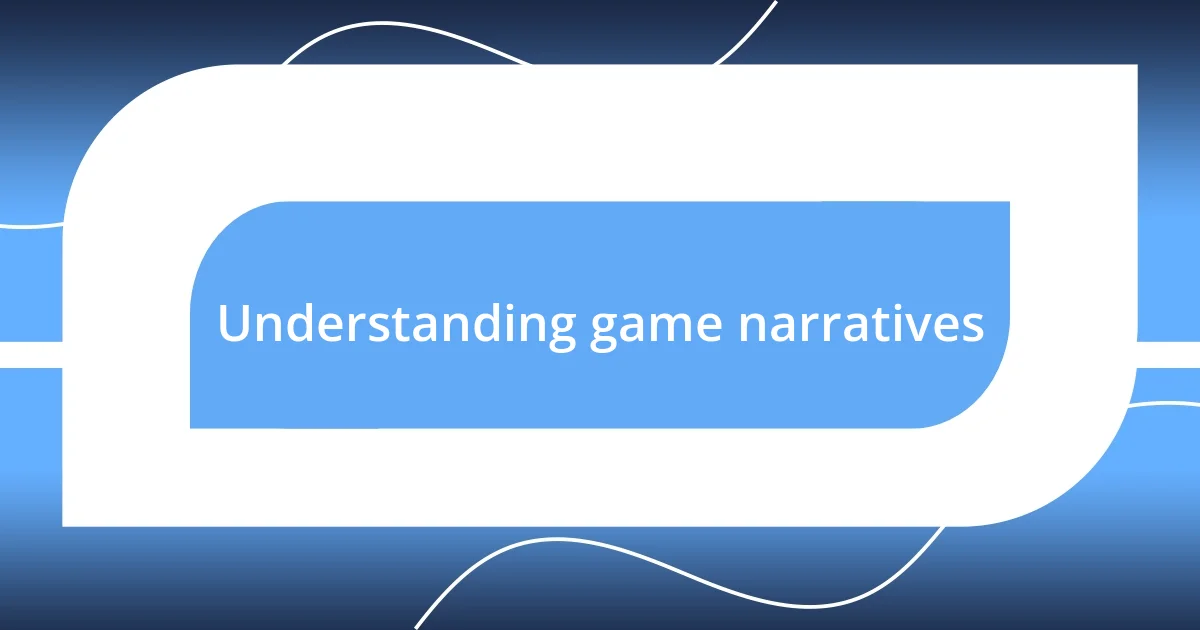
Understanding game narratives
Game narratives serve as the backbone of our gaming experiences, weaving together themes, character arcs, and immersive worlds. I remember playing “The Last of Us” and feeling an emotional whirlwind as I connected with Joel and Ellie on their harrowing journey. It made me ponder: how do these narratives resonate so deeply with us?
The intricacy of storytelling in games allows players to become part of something bigger. When I played “Life is Strange,” each decision I made felt heavy with consequence, echoing my real-life choices and values. Have you ever found yourself questioning your morals because of a game’s narrative? It’s powerful how storytelling can blur those lines between right and wrong.
Understanding game narratives also means appreciating the collaborative effort behind them. From writers to designers, each element contributes to creating an emotional landscape that players traverse. Reflecting on the storytelling in “BioShock,” I often think about how games trigger personal reflections—do you find yourself contemplating your beliefs long after the screen goes dark? That’s the magic of game narratives; they linger in our minds, inviting us to explore and reflect.
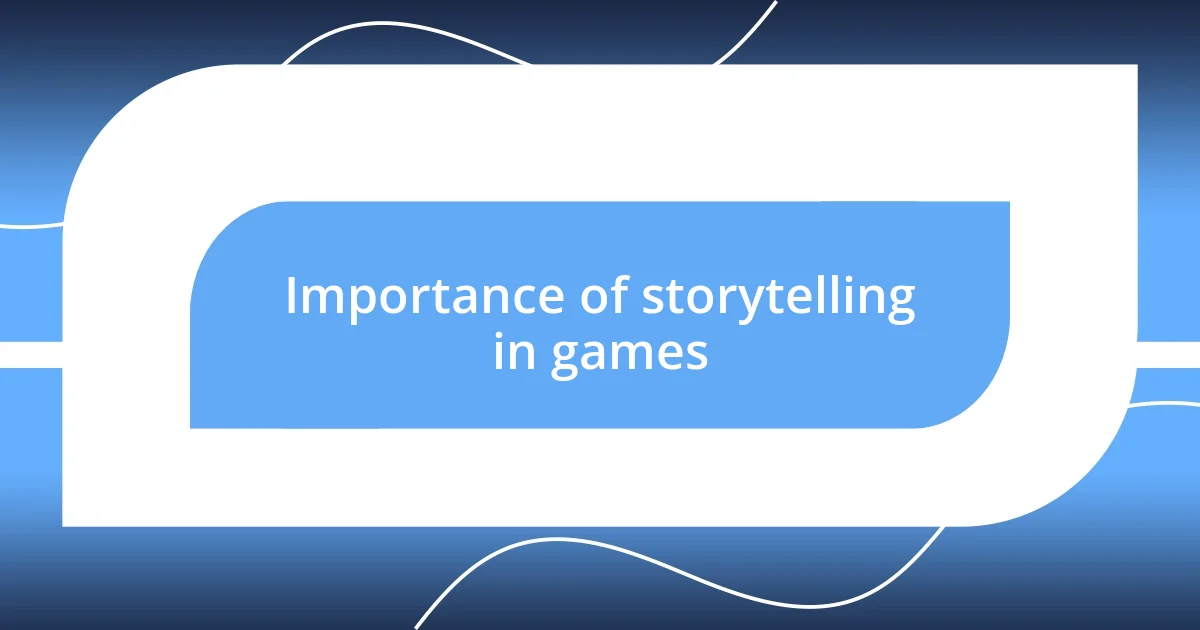
Importance of storytelling in games
The significance of storytelling in games goes beyond mere entertainment; it shapes our emotional experiences. When I recall playing “Red Dead Redemption 2,” I can still feel the weight of Arthur Morgan’s journey — his quest for redemption resonated with my own life experiences. It’s compelling how game narratives can reflect our struggles and triumphs, offering a safe space to explore complex emotions.
Furthermore, a well-crafted story can enhance player engagement and immersion. I vividly remember being completely absorbed in “The Witcher 3.” The rich lore and multi-dimensional characters drew me in so deeply that I found myself making decisions aligned with Geralt’s moral compass, often questioning what I would do in his situation. Have you ever felt so connected to a character that their choices became your own? That’s the beauty of storytelling; it allows us to step into another person’s shoes and experience their world firsthand.
Also, games with strong narratives foster community and conversation. Think about discussing plot twists or character developments with fellow gamers – it’s like being part of a larger family, united by shared experiences. I’ve had countless nights spent chatting about the choices in “Mass Effect,” debating who should survive and why. These discussions create lasting connections, demonstrating how storytelling in games can significantly enrich our social interactions.
| Aspect | Example |
|---|---|
| Emotional Impact | “Red Dead Redemption 2” – Arthur Morgan’s quest for redemption resonates deeply |
| Player Engagement | “The Witcher 3” – Decisions reflect personal morals, enhancing immersion |
| Community Building | “Mass Effect” – Discussions about choices create lasting connections |
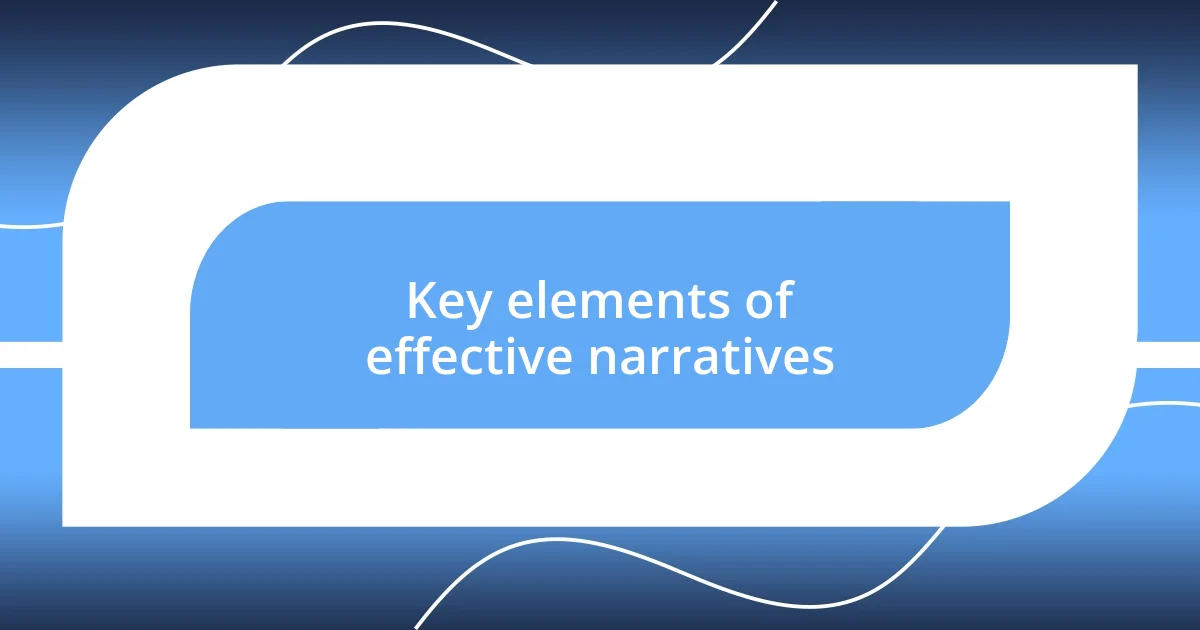
Key elements of effective narratives
Key elements of effective narratives lie in how they connect emotionally with players. I find that a strong emotional core often amplifies the overall experience. When I played “Celeste,” I was struck by how the protagonist’s struggles with anxiety mirrored my own. It’s fascinating how narratives can evoke such personal feelings, allowing players to peel back layers of their own lives while they navigate a character’s journey.
Here’s a breakdown of some essential elements that make game narratives compelling:
- Character Development: Well-crafted characters evolve, making them relatable. It enables players to form attachments and understand their motivations.
- Conflict: Central conflicts drive the story forward and create suspense, keeping players engaged. They want to see how the challenges will unfold.
- World-Building: An immersive world enhances the narrative; it’s like walking into a richly detailed painting where every corner invites exploration. I remember losing myself in the vast landscapes of “Breath of the Wild,” feeling the allure of every unexplored area.
- Choices and Consequences: Games that allow players to make choices create a sense of ownership over the narrative. Just thinking about my choices in “Detroit: Become Human” gives me chills. Each decision felt significant and shaped the outcome in profound ways.
These elements coalesce to form a narrative tapestry that resonates on multiple levels and stays with players long after they’ve stepped away from the game.
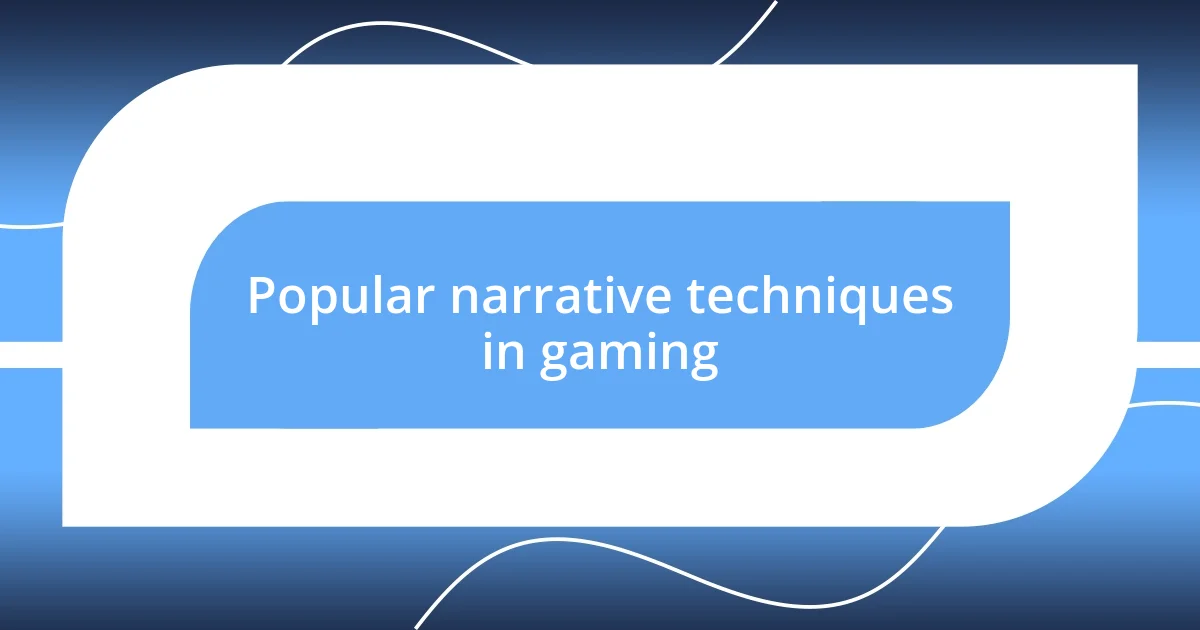
Popular narrative techniques in gaming
One popular narrative technique I find particularly captivating is the use of nonlinear storytelling. Games like “Chrono Trigger” or “The Legend of Zelda: Ocarina of Time” employ this technique beautifully, allowing players to experience the story from various angles and timelines. It’s almost like piecing together a puzzle where every fragment adds new depth. Have you ever replayed a game and noticed how differently you interpret events based on the choices you make? That’s the power of nonlinear narratives – they invite us to explore alternate realities while challenging our perceptions.
Another technique that deeply resonates with me is the incorporation of unreliable narrators. “Bioshock Infinite” effectively utilized this, where layers of truth and deception intertwine, making you question everything you believe. I remember feeling a sense of confusion and excitement as I tried to untangle the story threads. Have you ever felt manipulated by a game’s narrative, only to later appreciate the craftsmanship that went into it? It’s this complexity that makes you ponder your understandings and assumptions long after the credits roll.
Finally, the technique of player agency should not be overlooked. Games like “The Stanley Parable” give players the freedom to shape their narrative experience. It feels exhilarating to choose between paths that lead to wildly different outcomes. I’ve found that this sense of control can be surprisingly emotional. I often think back to moments when I walked away from a crucial decision, feeling the weight of my choice as if it mirrored real-life dilemmas. How does it feel for you to make choices that alter the course of a game’s story? For me, it’s a thrilling reflection of the choices we make every day.
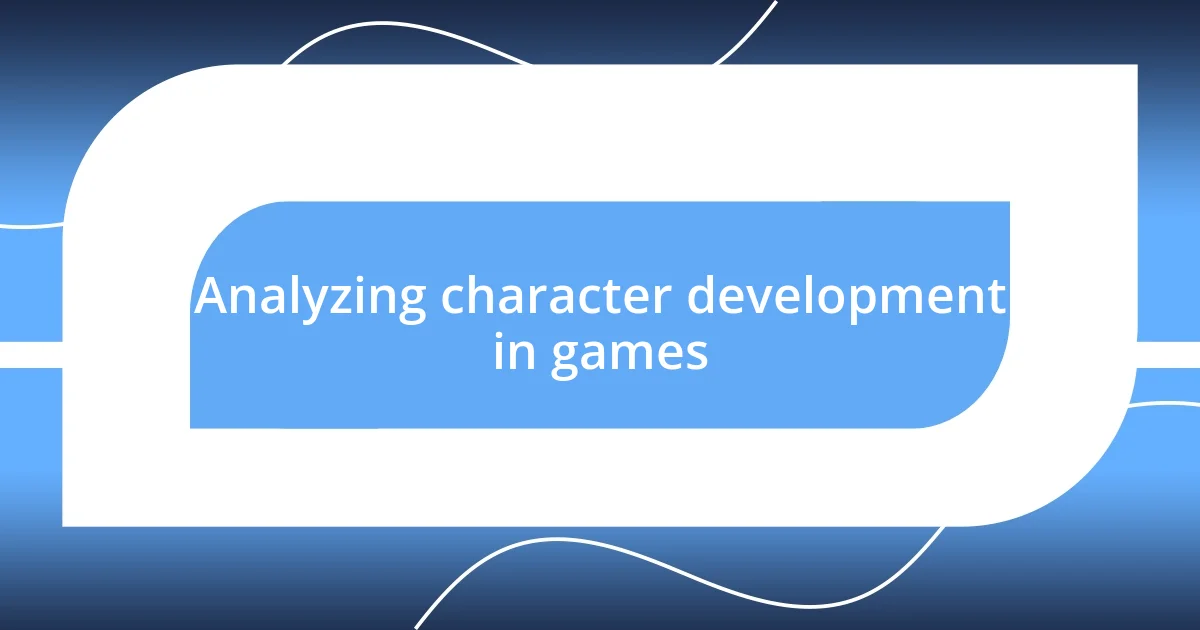
Analyzing character development in games
Character development is truly the heart of engaging game narratives. I remember diving into “The Last of Us” and really connecting with Ellie’s evolution. Watching her transition from a scared girl into a fierce survivor was so compelling that it made me reflect on my own growth in challenging situations. Have you ever felt inspired by a character’s journey to face your own fears?
The way characters change over time adds layers to the story. In “Mass Effect,” for instance, I was fascinated by how my choices shaped not just Commander Shepard, but also the fates of countless characters. Each decision felt heavy, almost like sculpting a personality. Do you think our actions in games can mirror our decision-making in real life? I’d argue they can, as the emotional weight we experience while controlling these characters can lead to genuine self-reflection.
Sometimes, character flaws make development even more dynamic. Look at Kratos in “God of War.” His journey from anger and revenge to understanding and redemption resonated with me on so many levels. It’s this exploration of vulnerability that adds depth to characters, making them feel authentic. When was the last time a character’s struggle made you rethink your own shortcomings? For me, it’s a constant reminder of the beauty in personal growth and the importance of embracing our complexities.

Future trends in game storytelling
As I look toward the future of game storytelling, I can’t help but feel excited about the potential for immersive technologies like virtual and augmented reality. Imagine stepping directly into a 3D world where your decisions shape every interaction. I recently tried a VR game that left me breathless—every choice felt tangible, as if I were living out my own story. Doesn’t that make you wonder how deeply you could become invested in a character when you’re not just watching, but actually inhabiting their reality?
Another trend I see emerging is the blending of gameplay mechanics with narrative progression. Games like “Hades” already showcase this fusion beautifully, where each run not only advances the plot but also enriches the player’s understanding of the characters within the story. It’s almost as if the gameplay itself tells a story, reminding me of the last time I played—I could feel my skills and decisions enhance my emotional connection to the characters. Have you ever experienced that harmonious blend of story and gameplay? It can transform a mere game into a profound narrative experience.
Finally, I firmly believe that stories of social impact in gaming will gain momentum. With titles addressing issues like mental health and climate change, I appreciate how they challenge players to reflect on real-world problems. I recall feeling deeply moved by “Celeste,” which tackled anxiety in a way that resonated with my own struggles. When games take on significant themes, they engage players on a personal level. What kind of impact do you think these stories can have on future generations of players? For me, they not only entertain but also educate and inspire change.












